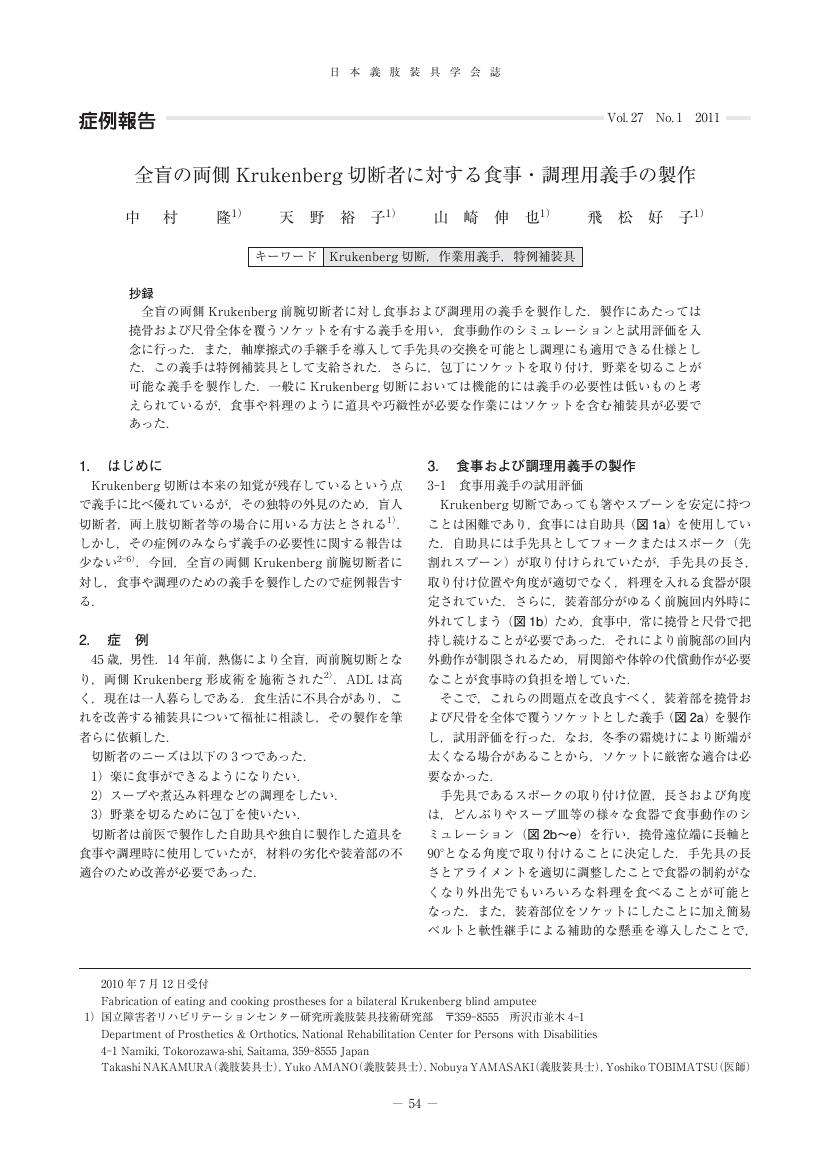3 0 0 0 OA 全盲の両側 Krukenberg 切断者に対する食事・調理用義手の製作
1 0 0 0 集約光インターコネクトにおける高性能トラフィックスケジューラ
- 著者
- 高前田−山崎伸也 吉瀬謙二 佐藤充
- 雑誌
- 第74回全国大会講演論文集
- 巻号頁・発行日
- vol.2012, no.1, pp.71-72, 2012-03-06
サーバー中に用いられるネットワークの性能向上のために,光ファイバーを活用したインターコネクトシステムが注目されている.特に,コンシューマ向け光インターコネクトデバイスの登場により,その低価格化が期待される.しかしコンシューマ向け光デバイスは,その価格の反面,送信端レーザーのVCSELに起因する低い信頼性による故障発生が懸念される.本稿では,信頼性を高めるためにコンシューマ向け光ケーブルを集約したサーバーインターコネクトを対象とした,トラフィックのスケジューリングアルゴリズムを提案する.流れるトラフィックの性質に応じた優先度を用いてスケジューリングすることで,高い性能を達成する.
1 0 0 0 OA 股義足歩行シミュレーションによる股継手抵抗特性の最適化
- 著者
- 青木 慶 山崎 信寿 井上 剛伸 山崎 伸也 三田 友記
- 出版者
- バイオメカニズム学会
- 雑誌
- バイオメカニズム (ISSN:13487116)
- 巻号頁・発行日
- vol.17, pp.217-226, 2004 (Released:2005-04-15)
- 参考文献数
- 9
- 被引用文献数
- 2 1
This paper describes the optimization of hip joint characteristics of a hip disarticulation prosthesis. We attempted to optimize the characteristics for improved ability to walk using our passive walking model, which can walk by utilizing mechanical properties of rigid body segments and joint resistance.In order to understand how the hip disarticulation prosthesis gait is performed, we interviewed two hip disarticulation prosthesis users. The interviews showed that practical gait in daily life is different from the gait at a training stage. These two types of gaits were named “practical gait” and “training gait.” Users indicated that the training gait velocity was slower than that of the practical gait. Moreover, in the practical gait the heel contact on the prosthesis side was more natural in comparison with the training gait.Gait measurements showed that the lumbar angle pattern has rapid extension and lateral bending involving the swing prosthesis in training gait. Step length on the sound side is in agreement despite the different types of gait. In practical gait, step length on the sound side agrees with that on the prosthesis side. Gait velocity in practical gait compared with training gait was 28% faster with subject 1 and 7% faster with subject 2. Therefore, practical gait has an improved gait velocity by swinging the prosthesis, as step length on each side is the same. Motion of prosthesis is achieved not by sound lower extremities but by lumbar flexion, extension, and lateral bending. Furthermore, practical gait reduces lumbar motion as much as possible, and reduces muscle force around the lumbar area.We developed a passive swing model by applying the above characteristics. This model is composed of eight rigid segments: upper torso, pelvis, upper extremities, thigh, shank-foot. Each joint has passive resistance by ligament. The sound hip and lumbar joint have active moments by muscle, which were obtained from measurement. The objective function for practical gait is defined by the following parameters: (1) difference of each step length, (2) amplitude of active moments, (3) difference of cycles between gait patterns and active moments. As these parameters are minimized, postures of segments, translational velocity, angular velocities and cycle, and amplitude of active moment are recorded. In comparison of subjects, calculated motion patterns on the prosthesis side were well in agreement, so this model is available to estimate hip joint characteristics.When this model simulates a condition of the current hip elastic characteristic weakened by half, the gait velocity is 6% faster and amplitude of lumbar lateral bending moment is reduced 26%. For this reason, weakening current elastic characteristics around the hip joint can easily control the swing of the prosthesis. As a result, adjustment of the hip elastic characteristic can improve the walk capability.
1 0 0 0 新しい義肢のパーツ オプションパーツ
- 著者
- 大石 暁一 山崎 伸也
- 出版者
- 医学書院
- 雑誌
- 総合リハビリテ-ション (ISSN:03869822)
- 巻号頁・発行日
- vol.36, no.11, pp.1110-1112, 2008-11
